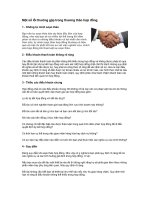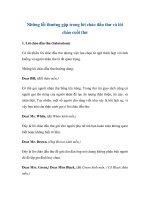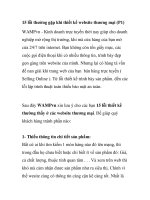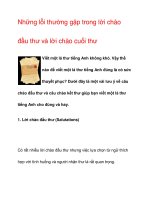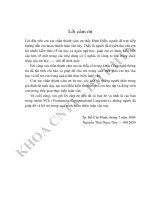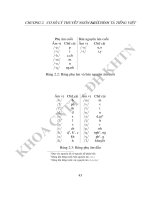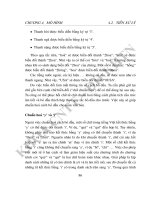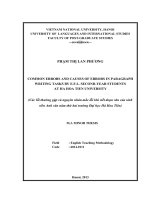CÁC lỗi THƯỜNG gặp của SINH VIÊN năm HAI NGÀNH BIÊN – PHIÊN DỊCH, đại học NGOẠI NGỮ, đại học QUỐC GIA hà nội KHI DỊCH VIỆT ANH TRONG GIÁO TRÌNH THỰC HÀNH DỊCH” của NGUYỄN VIỆT kỳ và GIẢI PHÁP
Bạn đang xem bản rút gọn của tài liệu. Xem và tải ngay bản đầy đủ của tài liệu tại đây (548.75 KB, 95 trang )
ABSTRACT
From the very first days of their professions, translators have always been entrusted
with the role of a communication facilitator who bridges the gap of understanding
between people coming from various cultures and speaking different languages.
Coming along with this trend, University of Languages and International Studies, VNU
also strives to train high-qualified translators to meet the demand of the whole society.
With the deep concerns about the situation, the researcher would like to conduct a
study entitled “Common errors made by 2
nd
year students majoring in Translation
and Interpreting at FELTE, ULIS, VNU in Translation Practice compiled by
Nguyen Viet Ky and suggestions for improvement”
The study aims at identifying common errors made by 2
nd
year students majoring in
Translation and Interpreting in course-book “Translation Practice” compiled by
Nguyen Viet Ky. Based on reasons shared by students and experienced teacher,
suggestions are offered for the improvement of not only surveyed students but also the
next generations of 2
nd
year students.
The major methods and procedures adopted throughout the study include
questionnaires, class observations, document observations, diary reports and online
interview. A combination of both quantitative and qualitative methods enables the
researcher to triangulate the data in order to produce the rich and reliable findings.
With this approach, the researcher ensures the validity as well as the reliability of the
study. Hopefully, the study proves beneficial to fresh would-be translators at FELTE,
ULIS, VNU.
i
TABLE OF CONTENTS
TABLE OF CONTENTS ii
CHAPTER 1: INTRODUCTION 1
1.1 Statement of problem and ra"onale for the study 1
1.2 Aims of the study 2
1.3 Signi*cance of the study 3
1.4 Scope of the study 3
1.5 Structure of the study 4
CHAPTER 2: LITERATURE REVIEW 4
2.1 Transla"on 5
2.1.1 The concepts of transla"on 5
2.1.2 Transla"on quality assessment 6
2.2 Transla"on errors 10
2.2.1 De*ni"on of transla"on errors 10
2.2.2 Classi*ca"on of transla"on errors 11
CHAPTER 3: METHODOLOGY 17
3.1 Sampling 18
3.1.1 Teacher par"cipant selec"on 18
3.1.2 Student par"cipant selec"on 19
3.2 Data collec"on instruments 20
3.2.1 Ques"onnaires 20
3.2.2 Classroom observa"ons 21
3.2.3 Document observa"ons 21
ii
3.2.4 Diary reports 21
3.2.3 Online interview 22
3. 3 Data collec"on procedure 22
3.4 Data analysis methods 23
CHAPTER 4: FINDINGS AND DISCUSSION 24
4.1 Findings and discussion from ques"onnaires 25
4.2 Findings and discussion from class observa"ons, document observa"ons, diary reports and
online interview 29
4.2.1 Linguis"c errors 30
4.2.2 Transla"on errors 33
4.2.3 Possible causes 37
4.2.4 Sugges"ons 39
4.3 Comparison between *ndings from *ve instruments 39
4.3.1 Research ques"on 1: Common errors encountered by 2nd year students 39
4.3.2 Possible causes 40
4.3.3 Sugges"ons 41
CHAPTER 5: CONCLUSION 43
5.1 Major *ndings of the study 44
5.2 Limita"ons of the study and sugges"ons for further studies 45
REFERENCES 46
APPENDIX A 49
QUESTIONNAIRE 49
APPENDIX B 53
THƯ MỜI THAM GIA NGHIÊN CỨU 53
APPENDIX C 55
iii
DIARY EXTRACT FROM STUDENT CODED AS S1 55
APPENDIX D 58
DIARY EXTRACT FROM STUDENT CODED AS S2 58
APPENDIX E 60
DIARY EXTRACT FROM STUDENT CODED AS S3 60
APPENDIX F 62
INTERVIEW SCHEDULE 62
APPENDIX F 63
TEACHER INTERVIEW SUMMARY 63
LIST OF TABLES AND DIAGRAMS
LIST OF TABLES PAGE
Table 1 The model of common linguistic errors synthesized
by researcher
15
Table 2 The model of common translation errors synthesized 17
iv
by researcher
Table 3 Participants’ demographic information 20
Table 4 Common linguistic errors observed from
questionnaires
26
Table 5 Common translation errors observed from
questionnaires
27
Table 6 Lengthy and awkward expression errors 34
Table 7 Terminology errors 35
Table 8 Consistency errors 36
Table 9 Common errors from class and document
observations
39
Table 10 Suggestions offered by both teacher and students 39
LIST OF DIAGRAMS PAGE
Diagram 1 Data collection instruments 20
Diagram 2 Data collection procedure 23
Diagram 3 Possible causes of common errors synthesized from
multiple instruments
41
LIST OF CHARTS PAGE
Chart 1 Possible causes of common errors made by 2
nd
year
students observed from questionnaires
28
Chart 2 Suggestions to overcome errors observed from
questionnaires
29
v
LIST OF ABBREVIATIONS
TT Target text
ST Source text
TQA Translation quality assessment
FELTE Faculty of English Language Teacher Education
ULIS University of Languages and International Studies
VNU Vietnam National University
vi
vii
CHAPTER 1: INTRODUCTION
1.1 Statement of problem and rationale for the study
The massive global integration has witnessed a proliferation of translating as
Munday (2001, p5) accentuates “Throughout history written and spoken translations
have played a crucial role in interhuman communication”. More notably, the 21
st
century fosters nations around the world to come together in tremendous vigor to
address global challenges and promote socio-economic development; hence,
translators have been entrusted with the role of bridging the gap between people
coming from various cultures and speaking disparate languages. As a result, the
constant and growing essence for translators is perfectly comprehensible, and myriad
of universities all over the world offer translation courses in their academic year.
According to Caminade and Pym (1995), as cited in Munday (2001) at least 250
university-level bodies in over sixty countries offering four-year undergraduate and
postgraduate courses in this art of science.
Harmonizing with the blossom of discipline, University of Languages and
International Studies, a prestigious institution in Vietnam prominent for grooming
translators also strives to diversify and impose assorted pedagogical methods to
strengthen students’ translating competence. Students majoring in translation are
oriented towards intensive training from their 2
nd
year, which facilitates them to glory
in translation skills and lay a momentous foundation from the early stage. In this
training phase, more than ten generations of trainees follow the course-book
“Translation Practice” compiled by senior lecturer Nguyen Viet Ky. What is more,
texts in this course-book are extracted for both mid-term and end-of-term tests;
therefore, translating texts in this course-book precisely assists translator to-be in
sharpening their translation skills and harvesting better exam results.
1
Nonetheless, tackling Vietnamese-English translations poses unprecedented
challenges for sophomores as they are at the initial drilling process and not truly aware
of translating-related theories and skills. Additionally, compared with English-
Vietnamese translation, Vietnamese-English translation is considered to be more
demanding to translator newbies as it requires not only outstanding language
proficiency but also requisite translation skills and broad background knowledge.
Furthermore, no empirical research papers have been conducted into the errors made in
2
nd
-year students’ translations. Therefore, in order to enrich the trainees’ translation
capacity, the researcher would like to cast a systematic and close observation at the
common errors made by 2
nd
-year students in translating texts and elicit
recommendations for them.
All these above-mentioned reasons have motivated the researcher to carry out a
study entitled “Common errors in Vietnamese-English translations made by 2
nd
-year
students majoring in Translation and Interpreting at FELTE, ULIS in Translation
Practice compiled by Nguyen Viet Ky and suggestions for improvement.”
1.2 Aims of the study
The research aims at identifying the common errors that 2
nd
year students majoring
in Translation and Interpreting from FELTE, ULIS, VNU might confront when
translating Vietnamese-English texts in “Translation Practice” compiled by Nguyen
Viet Ky. Once having brought these errors to light, the research investigates the
possible causes and puts forward some recommendations suggested by both students
and teachers. The research is expected to assist 2
nd
year QH2011 students in particular
and the next generations of 2
nd
year students at ULIS in general in addressing their
errors and improving the quality of their translation as well as their translation skills.
2
In order to achieve this goal, the current research is aimed at addressing the
following questions:
1. What are the common errors in the Vietnamese - English translations in “Translation
Practice” made by 2
nd
year students?
2. What are the possible causes of these common errors?
3. What are the suggestions in order to overcome these errors?
1.3 Significance of the study
Translation is a vast discipline of study and practice, which so far has seen a great
deal of research works. The study would be of great usefulness for the improvement of
Vietnamese – English translation of 2
nd
students and assists students in strengthening
their translation competence. Besides, the research helps teachers become more aware
of common errors students may confront while translating and serves as a reference for
them in the process of teaching translation. The findings of this research also can be
regarded as a valuable experience for the researchers who share the same interest in
this topic as well.
1.4 Scope of the study
The study population comprises both students and teachers as the errors made by
2
nd
year students are detected and offered suggestions by from the perspectives of
students and teachers. Regarding students, the participants include 81 students of three
classes, QH2011.E18; E19 and E20. They all gain experiences in translating
Vietnamese-English texts in “Translation Practice” compiled by Nguyen Viet Ky.
Additionally, the population involves senior lecturer Mr. Nguyen Viet Ky in
Translation and Interpreting Division who is the compiler of the course-book
“Translation Practice” and possesses considerable experience in teaching Translation
Practice for 2
nd
year students. Due to time and capacity constraint, the researcher
merely concentrates on detecting errors in Vietnamese – English translations in Unit 4
3
“Vietnam”. The Unit is selected among the three themes “Vietnam”, “Economy”,
“Health” in the second semester for two main reasons. Firstly, Unit 4 is advantageous
for researcher to arrange time and conduct observations. Besides, “Vietnam” is among
the popular themes which students confront during 3
rd
and 4
th
year at university.
1.5 Structure of the study
The rest of the study consists of the following chapters:
Chapter 2 - Literature review – introduces the most relevant published information on
translation, translation quality assessment and translation errors.
Chapter 3 - Methodology – provides a detailed description of the method adopted in
data collection and analysis.
Chapter 4 - Findings and discussion – presents the analysis and synthesis of the most
common errors made by 2
nd
year students, their possible causes and suggestions for
improvement.
Chapter 5 – Conclusion – summarizes major findings, limitations of the study and
suggestions for further research.
CHAPTER 2: LITERATURE REVIEW
4
This chapter sheds light on fundamental concepts of translation, the role as well
as the criteria for translation quality assessment, translation errors and the
classification of translation errors by analyzing, synthesizing related-topic previous
works and indicating their strengths as well as weaknesses. Besides, the gaps of
previous works and the theoretical model which the researcher utilizes to investigate
the common errors 2
nd
year students frequently confront is also fully illustrated in this
chapter.
2.1 Translation
2.1.1 The concepts of translation
The concepts of “translation” have been thoroughly discussed by a number of
researchers in various publications. According to Hartman and Stork (1972, p.713),
“translation is the replacement of a representation of a text in one language by as
equivalent text in a second language”. Hartman and Stork also assert that the goal of
translating is to as correctly as possible all grammatical and lexical features of the ST
by finding equivalents in the TT. It means that the translated version must ensure the
accuracy of the messages, the meaning of words from the ST to the TT.
The above-mentioned viewpoint was also supported by the renowned founder of
translation theories Newmark. Newmark (1995) defines that translation is a procedure
of transferring a written text into another language in the way that the author aimed in
the text. In other words, translation means rendering the meaning of a text into another
language in the same way that the author intended the text. From his point of view,
Newmark particularly expounds on two key points which are the transfer of written
text and the purpose of author; thus, translation means transferring not only language
but also ideas and purpose of the author in source text.
Another concept about translation can be found in Bell (1991) who defines this art
of science as the substitution of a representation of a text in one language by a
5
representation of an equivalent text in a second language. This concept also put strong
emphasis on accurately conveying the messages from ST to TT.
Seeing eye-to-eye with Newmark and Bell, Larson (1994) reaffirms that
translation as a process of replacing the form of the source language by the form of
target language. More importantly, Larson emphasizes two critical factors in
translation process. Firstly, translation needs studying the ST including lexicon,
grammatical structure, communication situation or cultural context. Secondly, after
studying the ST, it is “a must” to reconstruct this same meaning using the lexical and
grammatical which are proper in TT and its cultural context. From Larson’s indication,
it can be concluded that reading and writing skills are crucial skills for the success of a
translators. In other words, the acquisition of grammar and vocabulary plays pivotal
role during translation process. The definition of translation is reinforced by Landa
(2006) who defines translation as a reproduction of the meaning from one language to
another language in written form.
All in all, it can be witnessed that the above-cited definitions, though differed in
wording, all agreed on the nature of translation, denoting it as the accuracy of the
written transference of messages from one language into another.
2.1.2 Translation quality assessment
2.1.2.1 The role of translation quality assessment
Although various researchers have dissimilar ways of defining translation, all of
them share the same point of view that TQA is of great importance and benefit all the
time. Newmark (1995) emphasizes the great significance of TQA between the theory
and practice of translation. Furthermore, he states that TQA plays a vital role in
translational discipline as it enhances competence, entails the huge improvement in
language proficiency, background knowledge, comprehensive understanding about
6
topics or themes relating to the translations and supports translators to sort out the ideas
about translation.
Besides, Schiaffino (2005) shares the same opinion that without means of
translation assessment it is impossible to enhance the translation quality, nor is it
possible to know if the translation quality is good; and, if it is good, how to keep it that
way. Translation evaluation provides a method to objectively quantify a process,
reduce poor quality, increase customer satisfaction and create benchmarking as well as
competitive advantages.
The significance of translation criticism is continuously stressed by various
scholars. Tien and Bac (2008) also agree that the translation evaluation from teachers,
professional translators, translating companies and clients could figure out drawbacks
in your translation which enhances your translation and your translating competence;
therefore, it becomes an essential part in translating process.
From above mentioned studies, it can be summarized that TQA plays a pivotal role
for not only professional translators, their clients, translational researchers but also
trainee translators. TQA further enhances translating competence, language proficiency
and clients’ satisfaction.
2.1.2.2 Criteria for translation quality assessment
The very fundamental model of TQA is proposed by House (1986) which consists
of four main criteria including pre-linguistic studies, response-based psycholinguistic
studies, source text-based studies and studies based on pragmatic theories of language
use. Pre-linguistic studies cover the faithfulness to the ST. In other words, an adequate
translation should successfully convey the ideas of the original text. Response-based
studies can be approached from behavioristic views and functionalistic views. Nida
(1964) as cited in House (1986) proposes a criterion in which “equivalence of
response” is the key point of a good translation. The “equivalence of response” is
7
clearly reflected in the principle of dynamic equivalence. The dynamic equivalence
concentrates on naturalness, the message and readability. According to Nida, the
manner in which the receptors of a translation respond to the transition should be
equivalent to the manner in which the ST’s receptors to the original. Besides, it is the
purpose of a translation that is of great importance in assessing the quality of
translation. Thirdly, source text-based studies are oriented towards the translation text.
The translation is assessed mainly based on its forms and functions inside the system of
the receiving culture and literature. Last but not least, a functional-pragmatic model of
translation evaluation involves the analysis and comparison between the original and
its translation at three levels, namely the level of text, register and genre. These three
levels also refer to the same conclusion that is “equivalence” is fundamental criterion
of translation quality.
The above model asserted by House (1986) represents an early and general
description of TQA. Nearly ten years later, the criteria are discussed further by
Newmark (1995). Compared with earlier criteria of TQA, the model by Newmark is
particularly thorough since it suggests five essential steps from the beginning to the
end in translation evaluation process, including pre-evaluation and post-evaluation.
These five steps involve analyzing the original text to examine the purpose of the
author, interpreting the method of the translator in accordance with the purpose of the
author and the readership, comparing the translated version with the source text,
evaluating the quality and finally evaluating how the translation exerts impact on
readership. It can be seen that while House (1986) merely mentions criteria during the
process of evaluating, Newmark (1995) suggests vital steps to figure out the
importance of readership in TQA, a critical post-evaluation activity.
Building on previous studies from House (1986) and Newmark (1995), Tien and
Bac (2008) synthesizes and illustrates a comprehensive and specific method of seven
phases to evaluate the quality of a translation. Tien and Bac shares the same view with
8
House (1986) that equivalence plays an important role in the accuracy as well as the
quality of other translations. Besides, they support Newmark’s ideas and also propose
pre-evaluation and post-evaluation step. The comparison between source text and
translational product is the initial step in TQA so as to measure meaning equivalence
and examine the accuracy of the translation. Secondly, back translation can be applied
to identify the changes in meaning between the source text and the translation. Thirdly,
measuring comprehension from readership, clients or professional translations is
implemented. The first three steps are carried out in order to check the accuracy and
measure meaning equivalence to make sure that there are no omissions, no additions
and no changes of meaning, no over translation as well as no under translation. Last
but not least, it is vital to measure naturalness, readability and consistency. The
purpose of measuring naturalness is to examine whether the product achieves a natural
form in targeted language. The measurement of readability also supports the step of
checking naturalness. A good translation should be advantageous to read because it is
natural, accurate and appropriate in style and format. Finally, the translator should
check the consistency concerning terminologies, names, places, capitalism,
abbreviation and so forth. These seven basic steps of translation evaluation can be
applied for the translation of trainees.
Nevertheless, from a new approach, more recently, Williams (2009) claims that it
is better to see TQA from a broader sense in which TQA can be the combination of
both quantitative and qualitative method. TQA can be based on statistical
measurement, reader response, interviews and questionnaires. No matter the
assessment is on products, performance or competence, TQA should be drawn from the
criteria of “goodness”, the achievement of quality. Specifically, a high-quality
translation should ensure validity and reliability. Validity refers to an assessment
measuring what it is designed to measure such as necessary translation skills for
performance. Validity also includes predictive validity involving the consequence of
the assessment reflecting future performance. Reliability is an assessment which
9
creates the same results when repeatedly examined to the same population under the
same conditions. Williams proposes a score of questions in order to identify the
reliability such as “Are there any biases or undue variations in results over time? Is
there a mechanism for ensuring that evaluators do not fluctuate between excessive
rigour and extreme flexibility? Is the evaluator always objective?”.
Overall, researchers adopting different approaches have proposed different
definitions of a good translation. No matter what approach has been adopted, most
researchers agree with Tien and Bac (2008) that a good interpretation must ensure
accuracy, naturalness, readability and consistency. Accuracy means that the translator
exactly conveys the ideas and the meaning of original text to translated one with no
omissions and no additions. Naturalness can only be achieved provided that the
translator pays enough attention to the style of both source and targeted text. The
product should be smooth and natural for the sake of the targeted readership.
Readability is satisfactory when the translator makes no mistakes in grammar,
punctuation, spelling and so on; therefore, it is convenient for the readers to follow the
whole translation. Consistency refers to the systematic use of terminologies, names of
places, proper names and abbreviation.
2.2 Translation errors
2.2.1 Definition of translation errors
Prior to conducting empirical evaluation on the quality of translation, it is
indispensable to identify the translation errors and their classifications as Schiaffino
(2005) assumes that it is easier to agree on what constitutes an error rather than on
what constitutes quality in the abstract, and that an important factor in quality is the
absence of errors.
Mossop (1989) describes translation errors as “a given rendering will be deemed
to be non-translation if it fails to conform to the concept of translation predominant in
10
the target culture”. He identifies translation errors in terms of cultural norm and formal
equivalence. It means that the definition of translation error by Mossop (1989) includes
the achievement of formal equivalence but excludes other critical factors such as
smoothness, readability and consistency in translational product. Besides, formal
equivalence as Nida and Taber (1982) defines as a method of translating literally and
protecting rhythm, special stylistic forms, expression in syntax and lexis, metaphor,
word play and so on; therefore, formal equivalence is mainly used in translating poems
and songs, not all kinds of texts.
A more thorough notion of error is proposed by Pym in 1992. Compared with
the definition by Mossop (1989), Pym suggests a large number of translation errors.
However, these errors are not systematically classified.
Ten years later, Aveling (2002) illustrates a more comprehensive and systematic
notion of translation errors. In his opinion, translation errors occur when translator fails
to gain equivalence, adequacy and accuracy. This definition is more comprehensive as
it stresses that equivalence covers many different types. Besides, it is more systematic
because Aveling emphasizes that translation errors can be divided into two
categorization including “dumb mistakes” and “deliberate mistakes”. The former is due
to the lack of translator’s competence, and the latter occurs when translator poses a
purpose to recreate the text.
2.2.2 Classification of translation errors
Not only the definition but also the classification of interpreting errors has
attracted a myriad of efforts from scholars and researchers. Nevertheless, due to the
complexity of this practice, it remains intricate to establish a single comprehensive list
of all the translation errors observed. This part, therefore, just attempts to review some
of the most noticeable study intro translation errors, and building on those studies, the
11
researcher proposes a list of translation errors which can be regarded as the foundation
for the error analysis of this study.
Hejwowski Krzysztof (1992) divides translation errors into four main types:
errors of syntagmatic surface translation, errors of mistaken interpretation, realization
errors and meta-translation errors. The first type includes equivalents, false friends,
calques and unjustified borrowings. The second type covers misreading syntagms and
wrong interpretation of verb frame, misinterpret scenes and scripts and misreading the
text modality. The third type covers TL errors, wrong evaluation of recipients’
knowledge and insufficient of knowledge of subject-matter. The final type comprises
translation technique, additions, omissions, two versions, too many or two few
footnotes, a wrong translation strategy, corrections and changing the text’s
intertextuality. Nevertheless, this approach is complicated and troublesome for
researcher to figure out translations errors of professional translators in general and
undergraduates in particular.
Three years later, translation errors were categorized more logically by the
founder of translation Newmark (1995, p189) in which translation errors consists of
two main types that are referential errors and linguistic errors. “Referential errors are
about facts, the real world, propositions not words”. Linguistic errors involve mistakes
due to the lack of translator’s competence such as the use of articles, prepositions,
punctuations, tense, voice, subject-verb agreement, word choice, spelling collocations,
idioms and so forth. The second categorization of Newmark is logical and appropriate
to evaluate the quality of translations in general, especially the translations of
undergraduates as they are at the early stage of training. Thus, the lack of competence
is completely understandable.
While agreeing somewhat with Newmark’s discussion, Nord (1997),
nevertheless, suggests further that translation errors should be classified into four main
types. Firstly, pragmatic translation errors are due to the lack of recipient orientation. It
12
means that the translator has no specific targeted readers in his mind; therefore, he has
no orientation when translating. Secondly, cultural translation errors occur with regard
to cultural-specific conventions or equivalence. A more detailed explanation can be
seen in part 2.1.2 of this chapter. In Venuti (2000, p126), Nida stresses that “Since no
two languages are identical, either in the meaning given to corresponding symbols or
in the ways in which such symbols are arranged in phrases and sentences, it stands to
reason that there can be no correspondence between languages”. Therefore, the failure
in translating cultural equivalences is unavoidable. The next type is linguistic
translation errors which Newmark (1995) also mentions. The final type is entitled text-
specific translation errors and it refers to the text-specific translation problem. The
translator has to deal with various problems in different texts.
On the other hand, Schiaffino (2005) classifies translation errors into three
principle categories. Firstly, errors of meaning occurs if the meaning of translation
becomes different from the meaning of SL. Secondly, errors of forms involves an error
of grammar, spelling, and other formal error that does not change the meaning of the
translation with respect to the SL. In this aspect, Schiaffino (2005) shared the same
viewpoint with Newmark (1995) and Nord (1997). The third categorization includes
errors of compliance. Although meaning and form are accurate, the translator fails to
convey the style guide, preferred terminology, and other customer requirement which
can cause unnaturalness, lack of readability and inconsistency in a translation.
The classification of translation error remains diverse; however, most scholars
agree with Wang Baorong (2009). Baorong arrives at a mutual conclusion that
translation errors should be classified into three main types including pragmatic
translation errors, cultural translation errors and linguistic translation errors. Pragmatic
translation errors are caused by practical issues such as a lack of receiver orientation
and background knowledge. Cultural translation errors are related to equivalent
problems and methods to deal with cultural words. Linguistic errors occur due to the
13
lack in the proficiency of the translator. As Newmark (1995) points out linguistic errors
involves grammatical mistakes, punctuations, collocations, idioms and so forth.
Based on the above reviewed studies, the researcher has come up with a
comprehensive list of common errors which is considered as the foundation for error
analysis in this study. The error list is mainly based on the theories of Newmark
(1995), Nord (1997), Nord (1997), Schiaffino (2005), and Wang Baorong (2009). On
the basis of these theories, the list of errors to assess the quality of 2
nd
students’
translations can be divided into two categorizations including linguistic errors and
translation errors. Both these two types of errors are unavoidable as 2
nd
year trainees
still undoubtedly lacks English proficiency as well as the background knowledge about
translation theories. The list of errors is as followed:
LINGUISTIC ERRORS
Linguistic errors Inaccurate Accurate
Article Aeroplane is the fastest means
of travel that is in common use.
The Aeroplane is the fastest means
of travel that is in common use.
Capitalization The students are mostly from
south east Asia.
The students are mostly from South
East Asia.
Parts of
Speech
The woman whom talked with
you last night is my sister.
The woman who talked with you
last night is my sister.
Preposition I congratulated her for her
success.
I congratulated her on her success.
Punctuation We all watched Titanic , it was
a great movie!
We all watched Titanic . It was a
great movie!
Spelling If you like your mother's new
wallpaper, you'll complement
her on her decorating skills.
If you like your mother's new
wallpaper, you'll compliment her
on her decorating skills.
Singular and
plural forms
He does his homeworks after
having dinner
He does his homework after having
dinner.
14
Subject-verb
agreement
Everyone think her saying is
right.
Everyone thinks her saying is right.
Tense She had written to him last
week.
She wrote to him last week.
Lexical choice I ran into my formal teacher. I ran into my former teacher.
Table 1: The model of common linguistic errors synthesized by researcher
TRANSLATION ERRORS
Item Source text Poor translation Suggested
translation
Lengthy and
awkward
expression
Mặc dù những kỹ năng
mang tính đặc thù môn
học là rất quan trọng,
nhưng sinh viên hiện
nay cần nhiều hơn thế.
Họ cần những kỹ năng
khác như đàm phán,
lập kế hoạch hành động
và xây dựng quan hệ.
Although skills which
have subject-specific
characteristics are very
important, students
today need more than
that. They need other
skills. For example, they
need negotiation skill.
They also need action
planning skill. Building
relationship is also an
important skill which
students need.
Although subject-
specific skills are of
importance, students
today need more than
that. They need other
skills including
negotiation, action
planning and
networking.
Accuracy Muốn thúc đẩy ngành
du lịch và dịch vụ địa
phương, cần đẩy mạnh
công tác đào tạo nghề,
In order to promote
tourism, it is necessary
to stimulate job-related
matters.
In order to promote
local services and
tourism, it is
necessary to stimulate
15
truyền nghề và phát
triển nghề.
Omission of
ideas.
vocational training,
professional
transmission and
development.
Naturalness Giờ thì ai cũng biết chi
tiết của vụ xì căng đan
đó.
Everybody know the
details of the scandal.
The details of the
scandal are now
common knowledge.
It is more
natural to use
noun in
English.
Consistency Biến đổi khí hậu gây ra
những thách thức to
lớn. Hiên tượng này
đang gây ra những tác
động to lớn ở cực. Tác
động của biến đổi khí
hậu liên quan đến
lượng mưa tăng và
mực nước biển dâng
cao.
Climate change poses
huge challenges. CC is
is having dramatic
effects in the Arctic. The
effects of climate change
includes precipitation
and higher sea levels.
Inconsistency in
the use of
abbreviation
CC poses huge
challenges. CC is
abstract to us, but in
the Arctic it is having
dramatic effects. The
effects of CC
includes precipitation
and higher sea levels.
Term Có 5 tiêu chí để 1 biên
tập viên quyết định một
câu chuyện nào đó có
đáng được đưa tin hay
không. Đó là: Thời
gian của sự kiện, tầm
There are 5 criteria for
an editor to decide
whether an incident is
newsworthy or not: the
time, the importance, the
venue, the incident-
There are 5 criteria
for an editor to decide
whether an incident is
newsworthy or not:
timing, significance,
proximity,
16
quan trọng của nó và
mức độ cảm xúc mà đó
có thể gây ra cho người
đọc.
related celebrities, and
the level of emotions it
affects on readers.
The incorrect use
of terminologies.
prominence and
human interest.
Table 2: The model of common s synthesized by the researcher
Summary
This chapter demonstrates a conceptual framework of previous studies pertaining to
translation and its equivalence, the essence and criteria for translation quality
assessment, translation errors and its categorization. More significantly, a detailed
discussion of gaps, contributions as well as theoretical background for this study,
particularly the comprehensive list of errors which can be considered as the
foundation for the error analysis of this study is also displayed.
CHAPTER 3: METHODOLOGY
This chapter provides a detailed description of the method adopted in data
collection and analysis. It comprises methods, the size and the properties of samples
and a thorough justification of five data collection instruments. Moreover, the data
collection procedures are also clearly indicated.
The researcher attempts to address the research questions from both qualitative
and quantitative approach. According to Lichtman (2006), the fundamental distinction
between these two research methods is that quantitative method explains a
17
phenomenon by collecting numeral data and using mathematically-based method. By
contrast, qualitative data must be analyzed by words, images and objects. Johnson and
Christensen (2008) also share the same viewpoint and further indicate that by using
statistical analysis, quantitative approach can test the theory and it is measurable,
objective, unbiased and precise. While quantitative research seeks for logical
explanation, qualitative approach strives for in-depth description, the depth of the
phenomenon, discovery and shared interpretation. Therefore, from a combination of
quantitative and qualitative approach, the researcher can compare, contrast,
supplement and especially produce the most adequate outcomes. Five main data
collection instruments including questionnaires, classroom observations, document
observations, diary and only interview are fully employed in this research.
3.1 Sampling
Throughout the study, all the selected participants were mentioned neither in
real names or pseudonyms. They will be coded with letters and numbers to preserve
their rights of privacy. Furthermore, the participants were selected via strict sampling
procedures to ensure their representativeness of the whole population.
3.1.1 Teacher participant selection
Based on purposive sampling, an experienced senior lecturer coded as T in
charge of QH.2011.E18, QH.2011.E19, and QH.2011.E20 was selected to participate
in the study. Having worked in training field for fifteen years in Translation and
Interpreting Division, ULIS, VNU, T possessed considerable experiences and deep
insights of students’ competence. Hence, the recommendations from T were especially
priceless to not only students but also other lecturers.
18
